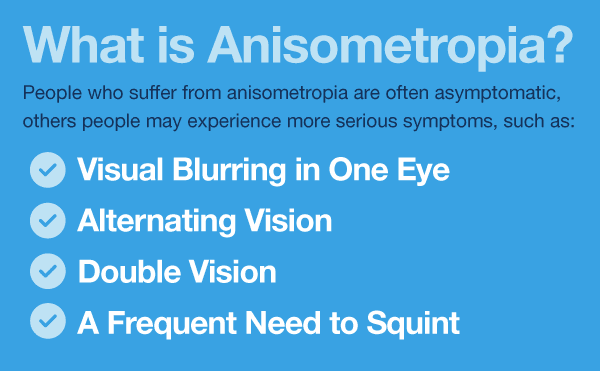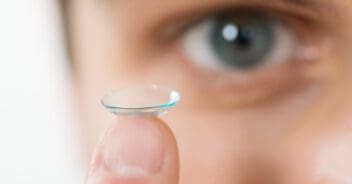Guide to Anisometropia (& Treatment Options)
Home / Eye Conditions & Eye Diseases /
Last Updated:
Anisometropia is a condition where there’s unequal refraction between a person’s eyes, leading to symptoms like visual blurring and double vision. Two main types, relative and absolute anisometropia, can affect individuals differently. Anisometropia treatment, ranging from corrective lenses to surgery, is essential to correct the condition and prevent long-term visual complications.
Table of Contents
It often manifests in few symptoms, but at its most severe, anisometropia can cause visual blurring, alternating vision, double vision, and a frequent need to squint. It can even cause amblyopia.
There are two broad types of anisometropia. The first is relative anisometropia, which occurs when a person’s eyes refract relatively equally, but one eye is a different size than the other, causing the images the eyes give the brain to be different sizes.
The other is absolute anisometropia. This type has several subtypes, and it occurs when there is a difference in the refractive power of both eyes. Absolute anisometropia is more common than relative anisometropia.
Amblyopia, also called lazy eye, is a condition that generally presents as a child’s eyes are developing between birth and the age of 8. If you notice your child squints to see, tilts their head to get a better look at things, or has eyes that cross or wander, take them to a doctor as soon as possible.
Amblyopia can be corrected. It can affect self-confidence and grades, as the child struggles to see a teacher’s board and may grow self-conscious about their eyes or intelligence.
Treatment for anisometropia can involve corrective lenses or surgery. Corrective lenses are only good for those with a difference between their eyes of 4D or less. Children under 12 and those with severe anisometropia are generally advised to use contacts, while others can often use glasses for correction.
Surgery directly alters one or both eyes to improve vision. It is sometimes used in conjunction with corrective wear.

What Is Anisometropia?
Anisometropia is a condition where there is unequal refraction between a person’s eyes. Most people’s eyes have a similar level of refraction, with a difference between the eyes of less than 1.0 diopters (D). In technical terms, a diopter is the reciprocal of the focal length in meters. It is a primary measurement for corrective lenses.
People who suffer from anisometropia are often asymptomatic, showing no immediate sign that anything is wrong with their vision. Others may experience mild vision problems, but none that are especially noticeable unless they are examined.
You deserve clear vision. We can help.
With 135+ locations and over 2.5 million procedures performed, our board-certified eye surgeons deliver results you can trust.
Your journey to better vision starts here.
Other people may experience more serious symptoms, such as:
- Visual blurring in one eye.
- Alternating vision.
- Double vision.
- A frequent need to squint.
Anisometropia with a difference between the eyes of greater than 3D should be treated in children as soon as possible, as it can lead to amblyopia (discussed below).
Older children and adults are more difficult to fully treat. Some recovery is still possible, but a full correction of vision may not be.
The severity of these symptoms may sometimes be bad enough that a person has great difficulty seeing out of one or both eyes. Whatever the severity of the symptoms, it is a good idea to see a doctor as soon as you notice a problem, as it can generally be corrected with lenses or surgery.
Types of Anisometropia

There are two broad categories of anisometropia: absolute anisometropia and relative anisometropia. Absolute anisometropia is then divided further.
Relative anisometropia is when the total refraction of the two eyes is the same (or at least similar enough not to qualify as anisometropic), but there is a difference in axial length between the eyes. Put in simpler terms, it is when the eyes are similar in refractive power but of different sizes. This means both eyes put out a clear image, but the images are of different sizes.
Absolute anisometropia occurs when the total refraction of the two eyes differs enough to be a problem. This condition is then further categorized, depending on how each eye refracts.
- Simple anisometropia: One eye sees normally, while the other is myopic or hypermetropic.
- Compound anisometropia: Both eyes are myopic or hypermetropic (also called ametropic).
- Mixed anisometropia: One eye is myopic; the other is hypermetropic.
- Compound astigmatic anisometropia: Both eyes are astigmatic, but to an unequal degree.
- Simple astigmatic anisometropia: One eye is either myopic or hypermetropic, and the other is astigmatic.
What Is Amblyopia?
Anisometropia can lead to amblyopia in severe cases. Amblyopia, often known as lazy eye, is a condition where the eyes and brain do not act as unified as they should.
This condition usually develops if there is a problem (like anisometropia) when a child is developing. Visual problems can disrupt important growth and learning processes, leading to problems.
Amblyopia can lead to eyes that wander or cross, with the brain learning to pick a dominant eye and ignore the nondominant one. If a child (or adult) squints to see clearly, tilts their head to get a better look at things, or has eyes that cross or wander, they should be examined by a doctor.
Like anisometropia, amblyopia is also treatable.
Treatment for Anisometropia

Anisometropia can be treated in a number of ways. Corrective lenses are commonly used, but they only work for those with a difference of less than 4D between their eyes.
With children under the age of 12, it generally recommended that sight be corrected with contact lenses. This ensures the best possible vision in both eyes, as contact lenses can aid their development.
Older children and adults can generally use either contacts or glasses to correct their vision. Those with severe anisometropia are generally advised to use contact lenses.
The preferred method of treatment for patients with anisometropia is corrective surgery, which can sometimes permanently solve most or all of the problem. Typical surgical therapies include:
- Refractive corneal surgery. Used to improve the cornea’s refraction of light, this surgery can correct unilateral myopia, hypermetropia, and astigmatism.
- Removal of the crystalline lens. The crystalline lens is your eye’s natural lens. For some people, removing the lens can actually improve their overall vision. The sight in that eye can then be adjusted with special glasses or further surgeries.
- Intraocular lens implantation. Intraocular lens implantation (IOL) is a relatively common surgery for those with a cataract or astigmatism in their eye that is seriously impacting their life. While there are several variations of this surgery, the eye is generally cut precisely so a doctor can break up the natural lens. Then, a plastic lens is put in its place to correct vision.
- Phakic IOL. This intraocular lens implantation is similar to the above surgery, but it does not remove the crystalline lens. Instead, the intraocular lens is placed in the eye with the natural lens. The two will then work together to improve vision.
Any surgery carries risks. While the above surgeries are not especially dangerous, complications are still possible that could lead to blindness, a reduction in visual clarity, or infection. More commonly, you may experience redness or swelling.
Talk to your doctor about any concerns you have. Report any problems you experience to your doctor immediately.
Follow your doctor’s recovery plan closely. During this vulnerable recovery time, it’s easy to damage the eye. Ask your doctor what to expect, what behaviors to avoid, and roughly how long it will take to recover.
Do not touch your eye as it heals, even though it may itch or ooze fluid. Your doctor will likely prescribe medicated eye drops to aid in your recovery.
You deserve clear vision. We can help.
With 135+ locations and over 2.5 million procedures performed, our board-certified eye surgeons deliver results you can trust.
Your journey to better vision starts here.
References
- Anisometropia. (November 15, 2016). Indian Centre for Health Informatics (CHI).
- How to Read Your Eyeglass Prescription. WebMD.
- Amblyopia. (January, 2017). The Nemours Foundation.
- Myopic Anisometropia: Ocular Characteristics Andaetiological Considerations. (2014). Clinical and Experimental Optometry.
- What Is an Intraocular Lens Implant? (January 11, 2018). WebMD.
This content is for informational purposes only. It may have been reviewed by a licensed physician, but is not intended to serve as a substitute for professional medical advice. Always consult your healthcare provider with any health concerns. For more, read our Privacy Policy and Editorial Policy.
